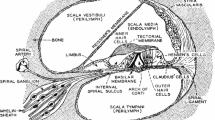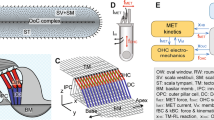Abstract
This paper reviews nonlinear and active cochlear models with special attention to the question whether a “second filter” is needed for modeling two-tone suppression below the characteristic frequency (CF). The concept of a unidirectionally coupled “second filter” is inconsistent with experimental evidence that major cochlear mechanical nonlinear phenomena are affected by alterations of the organ of Corti. A possible way of modeling the below-CF suppression is suggested in terms of an indirect effect mediated by a baseline shift of the cochlear partition.
Access this chapter
Tax calculation will be finalised at checkout
Purchases are for personal use only
Preview
Unable to display preview. Download preview PDF.
Similar content being viewed by others
References
Allen, J.B. (1980). “Cochlear micromechanics — a method for transforming mechanical to neural tuning within the cochlea.” J. Acoust. Soc. Am. 62, 930–939.
Anderson, S.D. and Kemp, D.T.(1979). “The evoked cochlear mechanical response in laboratory primates, a preliminary report.” Arch. Otolaryn. 224, 47–54.
Blachman, N.M.(1964). “Band-pass nonlinearities.” IRE Trans. Inform. Theory IT-10, 162–164.
Brownell, W.E., Bader, C.R., Bertrand, D. and Ribaupierre, Y. de (1985). “Evoked mechanical responses of isolated cochlear outer hair cells.” Science 227, 194–196.
Dallos, P., Harris, D.M., Relkin, E. and Cheatham, M.A.(1980). “Two-tone suppression and intermodulation distortion in the cochlea: effect of outer hair cell lesion.” In Psycho. Physiol. Behav. Stud. Hearing, Eds. van den Brink and Bilsen, Delft Univ. Press, Netherlands, pp242–249.
Davis, H.(1983). “An active process in cochlear mechanics.” Hearing Res. 9, 79–90.
de Boer, E.(1983). “Power amplification in an active model of the cochlea — short-wave case.” J. Acoust. Soc. Amer. 73, 577–579.
Diependal, R. J. and Viergever, M.A.(1983). “Nonlinear and active modeling of cochlear mechanics: a precarious affair” In Mechanics of Hearing, Eds. de Boer and Viergever, Martinus Nijhoff Pub., Delft Univ. Press, pp153–160.
Evans, E.F. and Wilson, J.P.(1973). “The frequency selectivity of the cochlea.” In Basic Mechanisms in Hearing, Ed. Moller, Academic Press, New York, pp519–551.
Goblick, T.J. and Pfeiffer, R.R.(1969). “Time domain measurements of cochlear nonlinearities using combination of click stimuli.” J. Acoust. Sco. Amer. 46, 924–938.
Goldstein, J.L. and Kiang, N.Y.S.(1968). “Neural correlates of the aural combination tone 2f1-f2.” Proc. IEEE 56, 981–992.
Hall, J.L.(1974). “Two-tone distortion products in a nonlinear model of the basilar membrane.” J. Acoust. Soc. Amer. 56, 1818–1828.
Hall, J.L.(1977). “Two-tone suppression in a nonlinear model of the basilar membrane.” J. Acoust. Soc. Amer. 61, 802–810.
Hall, J.L.(1981). “Observations ona nonlinear model for motion of the basilar membrane.” In Hearing Res. Theory Vol.1, Eds. Tobias and Schubert, Academic Press, New York, pp2–61.
Hubbard, A.E. and Geisler, C.D.(1972). “A hybrid computer model of the cochlear partition.” J. Acoust. Soc. Amer. 51, 1895–1903.
Jau, Y.C. and Geisler, C.D. (1983). “Results from a cochlear model utilizing longitudinal coupling.” Same reference as Diependal and Viergever, pp169–176.
Kemp, D.T.(1978). “Stimulated acoustic emissions from within the human auditory system.” J. Acoust. Soc. Amer. 64, 1386–1391.
Khanna S.M. and Leonard D.G.B.(1982). “Basilar membrane tuning in the cat cochlea.” Science 215, 305–306.
Kim, D.O., Molnar, C.E. and Pfeiffer, R.R.(1973). “A system of nonlinear differential equations modeling basilar-membrane motion.” J. Acoust. Soc. Am. 54, 1516–1529.
Kim, D.O.(1980). “Cochlear mechanics: implications of electrophysiological and acoustical observations.” Hearing Res. 2, 297–317.
Kim, D.O., Molnar, C.E. and Matthews, J.W.(1980a). “Cochlear mechanics: nonlinear behavior in two-tone responses as reflected in cochlear nerve fiber responses and in ear-canal sound pressure.” J. Acoust. Soc. Am. 67, 1704–1721.
Kim, D.O., Neely, S.T., Molnar, C.E. and Matthews, J.W.(1980b). “An active cochlear model with negative damping in the partition: comparison with Rhode’s ante- and post-mortem observations.” Same reference as Dallos et al, pp7–14.
Kim, D.O.(1984). “Functional roles of the inner- and outer-hair-cell subsystems in the cochlea and brainstem.” In Hearing Science: Recent Advances, Ed. Berlin, College-Hill Press, San Diego, CA, pp241–262.
Koshigoe, S. and Tubis, A.(1983). “A nonlinear feedback model for outer-hair-cell stereocilia and its implications for the respone of the auditory periphery.” Same reference as Diependal and Viergever, pp127–134.
LePage, E.L.(1981). “The role of nonlinear mechanical processes in mammalian hearing.” Ph.D. thesis, Univ. Western Australia, Nedlands, Australia.
Leshowitz, B.H. and Lindstrom, R.(1977). “Measurement of nonlinearities in listeners with sensorineural hearing loss.” In Psycho. Physiol. Hearing, Eds. Evans and Wilson, Academic Press, New York, pp283–292.
Matthews, J.W.(1983). “Modeling reverse middle ear transmission of acoustic distortion signals.” Same reference as Diependal and Viergever, pp11–18.
Mountain, D.C.(1980). “Changes in endolymphatic potential and crossed olivocochlear bundle stimulation alter cochlear mechanics.” Science 210, 71–72.
Mountain, D.C., Hubbard, A.E. and McMullen, T.A. (1983). “Electromechanical processes in the cochlea.” Same reference as Diependal and Viergever, pp1l9–126.
Neely, S.T. and Kim, D.O.(1983). “An active cochlear model showing sharp tuning and high sensitivity.” Hearing Res. 9, 123–130.
Neely, S.T. and Kim, D.O.(1985). “A model for active elements in cochlear biomechanics.” To be submitted for publication.
Netten, S.M. van and Duifhuis, H.(1983). “Modeling an active, nonlinear cochlea.” Same reference as Diependal and Viergever, pp143–152.
Pfeiffer, R.R.(1970). “A model for two-tone inhibition of single cochlear-nerve fibers.” J. acoust. Soc. Am 48, 1373–1378.
Pfeiffer, R.R. and Kim, D.O.(1975). “Cochlear nerve fiber responses: distribution along the cochlear partition.” J. Acoust. Soc. Amer. 58, 867–869.
Rhode, W.S.(1971). “Observations of the vibration of the basilar membrane in squirrel monkeys using the Mossbauer technique.” J. Acoust. Soc. Am. 49, 1218–1231.
Robertson, D.(1976). “Correspondence between sharp tuning and two-tone inhibition in primary auditory neurones.” Nature 259, 477–478.
Sachs, M.B. and Kiang, N.Y.S.(1968). “Two-tone inhibition in auditory nerve fibers.” J. acoust. Soc. Am. 43, 1120–1128.
Schmiedt, R.A., Zwislocki, J.J. and Hamernik, R.P.(1980). “Effects of hair cell lesion on responses of cochlear nerve fibers.I.” J. Neurophysiol. 43, 1367–1389.
Schmiedt, R.A.(1982). “Effects of low-frequency biasing on auditory nerve fiber activity.” J. Acoust. Soc. Am. 72, 142–150.
Sellick, P.M., Patuzzi, R. and Johnstone, B.M.(1982a). “Measurement of basilar membrane motion in the guinea pig using the MOssbauer technique.” J. Acoust. Soc. Am. 72, 131–141.
Sellick, P.M., Patuzzi, R. and Johnstone, B.M.(1982b). “Modulation of responses of spiral ganglion cells in the guinea pig cochlea by low frequency sound.” Hearing Res. 7, 199–221.
Siegel, J.H. and Kim, D.O.(1982). “Efferent neural control of cochlear mechanics? Olivocochlear bundle stimulation affects cochlear biomechanical nonlinearity.” Hearing Res. 6, 171–182.
Siegel, J.H., Kim, D.O. and Molnar, C.E.(1982). “Effects of altering organ of Corti on cochlear distortion products f2-f1 and 2f1-f2.” J. Neurophysiol. 47, 303–328.
Smoorenburg, G.F.(1972). “Combination tones and their origin.” J. Acoust. Soc. Am. 52, 615–632.
Smoorenburg, G.F.(1980). “Effects of temporary threshold shift on combination tone generation and two-tone suppression.” Hearing Res. 2, 347–355.
Weiss, T.F.(1982). “Bidirectional transduction in vertebrate hair cells: a mechanism for coupling mechanical and electrical processes.” Hearing Res. 7, 353–360.
Wightman, F.L., McGee, T. and Kramer, M.(1977). “ Factors influencing frequency selectivity in normal and hearing-impaired listeners.” Same reference as Leshowitz and Lindstrom, pp295–3 06.
Wilson, J.P. and Johnstone, J.R.(1973). “Basilar-membrane correlates of the combination tone 2f1-f2.” Nature 241, 206–207.
Zwicker, E.(1977). “Masking-period patterns produced by very-low-frequency maskers and their possible relation to basilar-membrane displacement.” J. Acoust. Soc. Am. 61, 1031–1040.
Zwislocki, J.J. and Kletsky, E.J.(1980). “Micromechanics in the theory of cochlear mechanics.” Hearing Res. 2, 505–512.
Author information
Authors and Affiliations
Editor information
Editors and Affiliations
Rights and permissions
Copyright information
© 1986 Springer-Verlag Berlin Heidelberg
About this paper
Cite this paper
Kim, D.O. (1986). A Review of Nonlinear and Active Cochlear Models. In: Allen, J.B., Hall, J.L., Hubbard, A.E., Neely, S.T., Tubis, A. (eds) Peripheral Auditory Mechanisms. Lecture Notes in Biomathematics, vol 64. Springer, Berlin, Heidelberg. https://doi.org/10.1007/978-3-642-50038-1_30
Download citation
DOI: https://doi.org/10.1007/978-3-642-50038-1_30
Publisher Name: Springer, Berlin, Heidelberg
Print ISBN: 978-3-540-16095-3
Online ISBN: 978-3-642-50038-1
eBook Packages: Springer Book Archive




